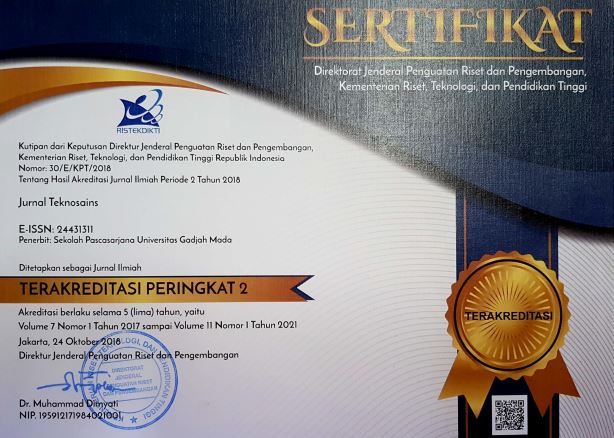UJI BIOKOMPATIBILITAS KOMPOSIT POLIVINIL ALKOHOLHIDROKSIAPATIT DENGAN PENGUAT CATGUT SEBAGAI BAHAN PENYAMBUNG PATAH TULANG
M. Taha Ma’ruf, Widowati Siswomihardjo, Marsetyawan HNE Alva Edy Tontowi(1*)
(1) Bagian Ilmu Bedah Mulut, Fakultas Kedokteran Gigi Universitas Mahasaraswati Denpasar-Bali
(*) Corresponding Author
Abstract
Bone fracture fixation devices have been using rigid metallic materials such as titanium, titanium-alloy or cobalt chrome. Besides having some advantages, the titanium fixation devices also have disadvantages, such as too high strength and stiffness. This continuously stimulates the bone, causing bone atrophy under the plate, further disrupting the growth of bones, especially in children. Other deficiencies of this metal material is its sensitivity to temperature changes and the spread of metal ions in several organs. Some of these shortcomings led to the need for a secondary operation. Bone fracture fixation devices, such as the poly-l-lactic acid (PLLA), can be absorbed by the body and show some other advantages. However, it also has some drawbacks due to the high crystalline products during the degradation process. Lactic acid monomer released after degradation causes cellular response at the implant site, which facilitates the release of chemical mediators, such as prostaglandine by fibroblasts and macrophages as a cause of bone resorption. Therefore, this study aimed to develop the use of other polymeric materials that have good biocompatibility,appropriate mechanical strength, and can be absorbed by the body, such as Polyvinyl Alcohol (PVA). Previous research suggests that the PVA-HA composite with catgut reinforcement has sufficient and stable mechanical strength to be used as bone fracture fixation material. The purpose of this study is to know whether the PVA-HA composite with catgut reinforcement has good biocompatibility without toxicity and hypersensitivity effects in experimental animals. Biocompatibility testing includes local cytotoxicity and type IV contact hypersensitivity test. This type of research is experimental in vivo laboratory using wistar rats (Rattus norvegicus). Testing is done through two phases, in which induction or sensitization phase is done by rubbing PVA-HA composite with catgut reinforced ointment powder on the ears that lasts up to 10 days. After being rested for 3 days, this is followed by a second phase contact (elicitation) on day 14 and observed in the period of 24, 48, and 72 hours. Observations were made macroscopically and ear thickness was measured with a micrometer. Local toxicity testing is done by implantation of PVA-HA composite with catgut reinforcement on the back catgut of wistar rats. After a certain time period, the implant material is opened,examined, and observed histologically under a light microscope. The results showed no discoloration or induration on the animal ears in all treatment and control groups, both for the sensitization and the elicitation phase. One way ANOVA statistical test showed that there were no significant differences in the results of measurements of the thickness of the wistar rats ears from all treatment groups before and after treatment on measures 24, 48 and 72 hours (ρ >0.05). Microscopic examination showed no infiltration of acute inflammatory cells such as neutrophils, basophils or eusinofil, and chronic inflammatory cell infiltration such as macrophages, lymphocytes and plasma cells. It can be concluded that the PVA-HA composite with catgut reinforcement is a material that does not cause toxicity and hypersensitivity in experimental animals, thus potentially can be used as bone fractures fixation material.
Keywords
Full Text:
PDFArticle Metrics
Refbacks
- There are currently no refbacks.
Copyright (c) 2015 M. Taha Ma’ruf, Widowati Siswomihardjo, Marsetyawan HNE Alva Edy Tontowi

This work is licensed under a Creative Commons Attribution-ShareAlike 4.0 International License.
Copyright © 2024 Jurnal Teknosains Submit an Article Tracking Your Submission
Editorial Policies Publishing System Copyright Notice Site Map Journal History Visitor Statistics Abstracting & Indexing









